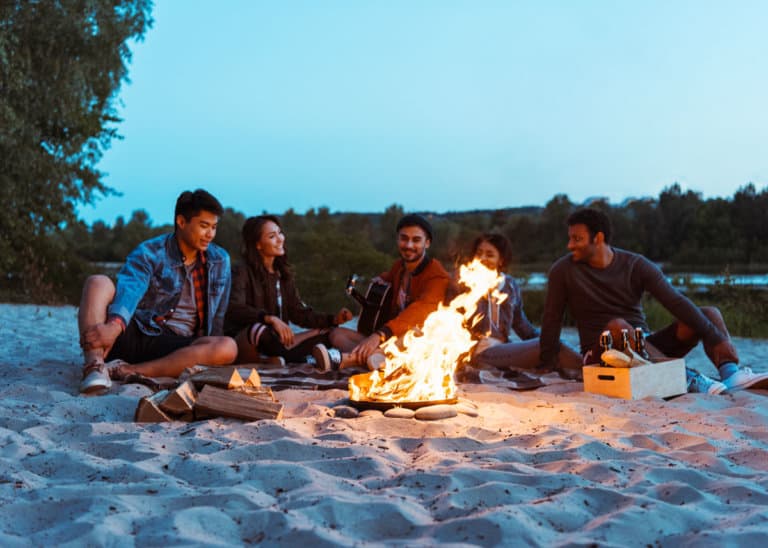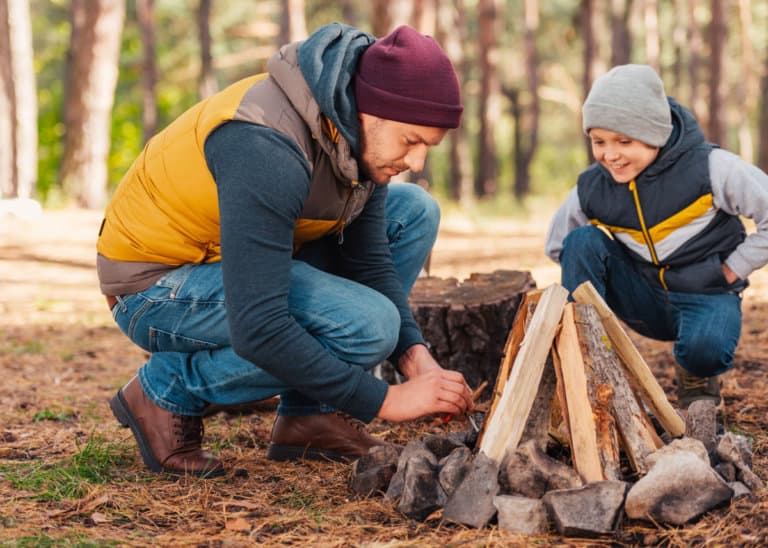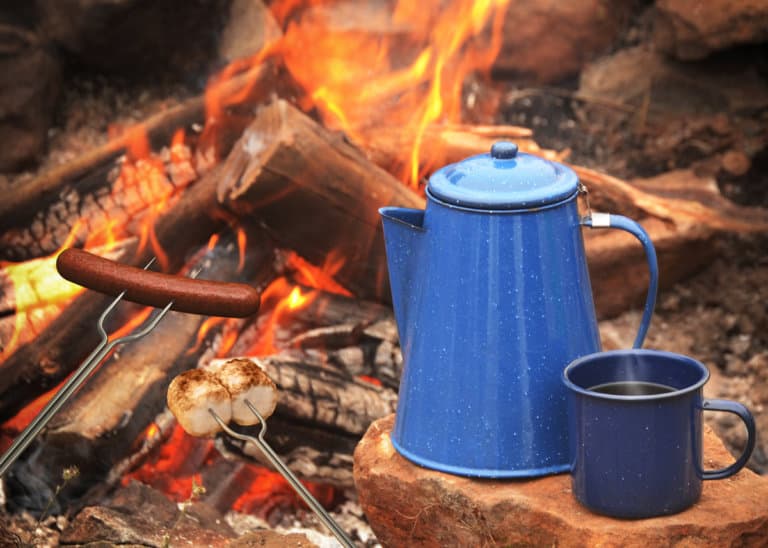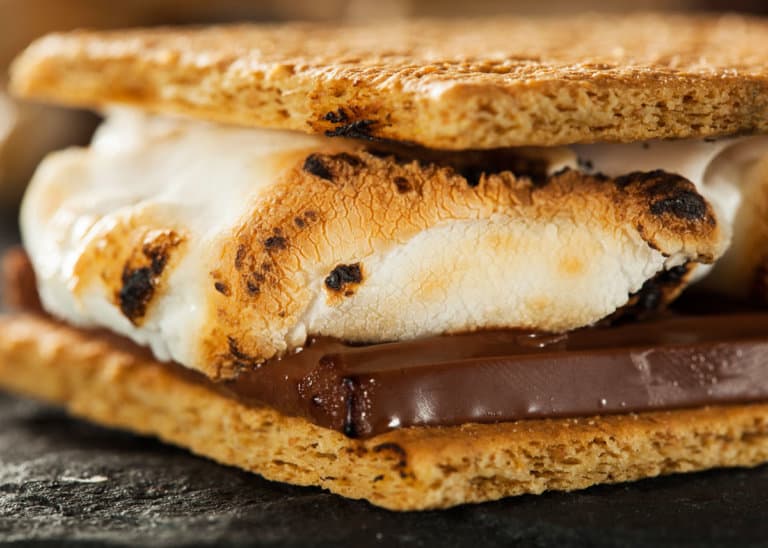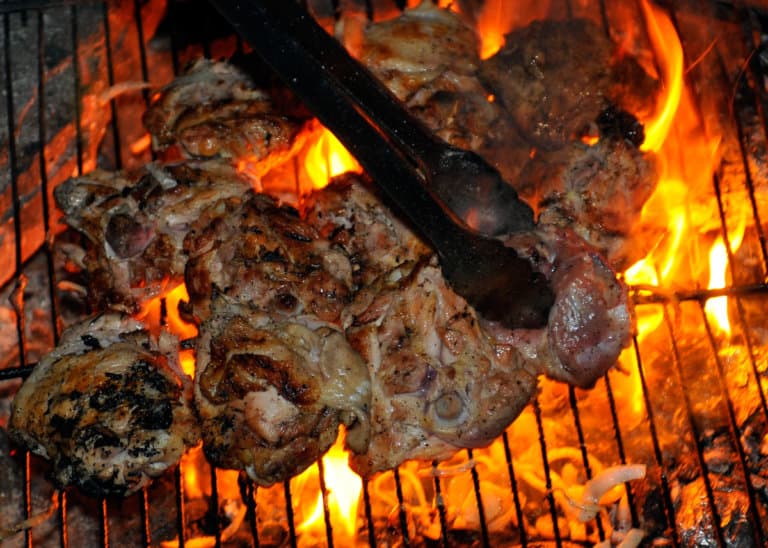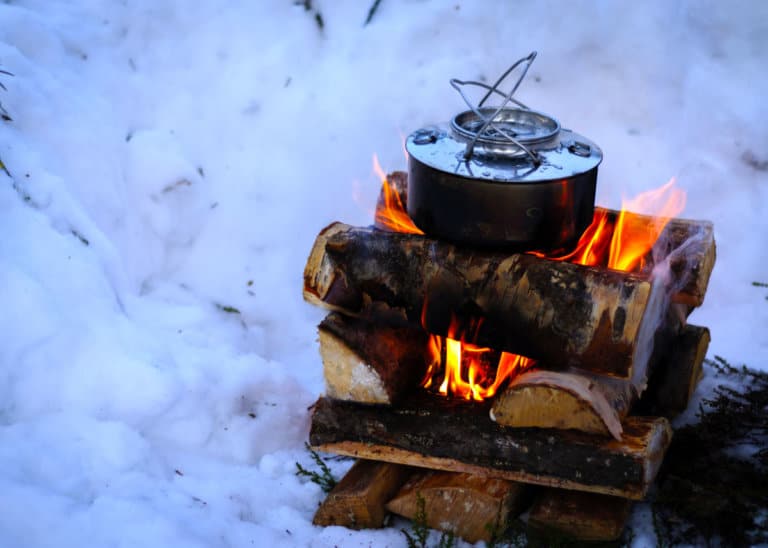How to Start a Fire Without Matches (or Lighter) 16 Ways
There are many ways to build a campfire. But do you know how to start a fire without matches?
To start a fire without a lighter or matches, you can try: sparks, friction, solar, chemicals, fire carrying, or finding fire. Each fire-starting method can be executed in a number of ways. Some include tools and planning, others can be done with supplies on hand.
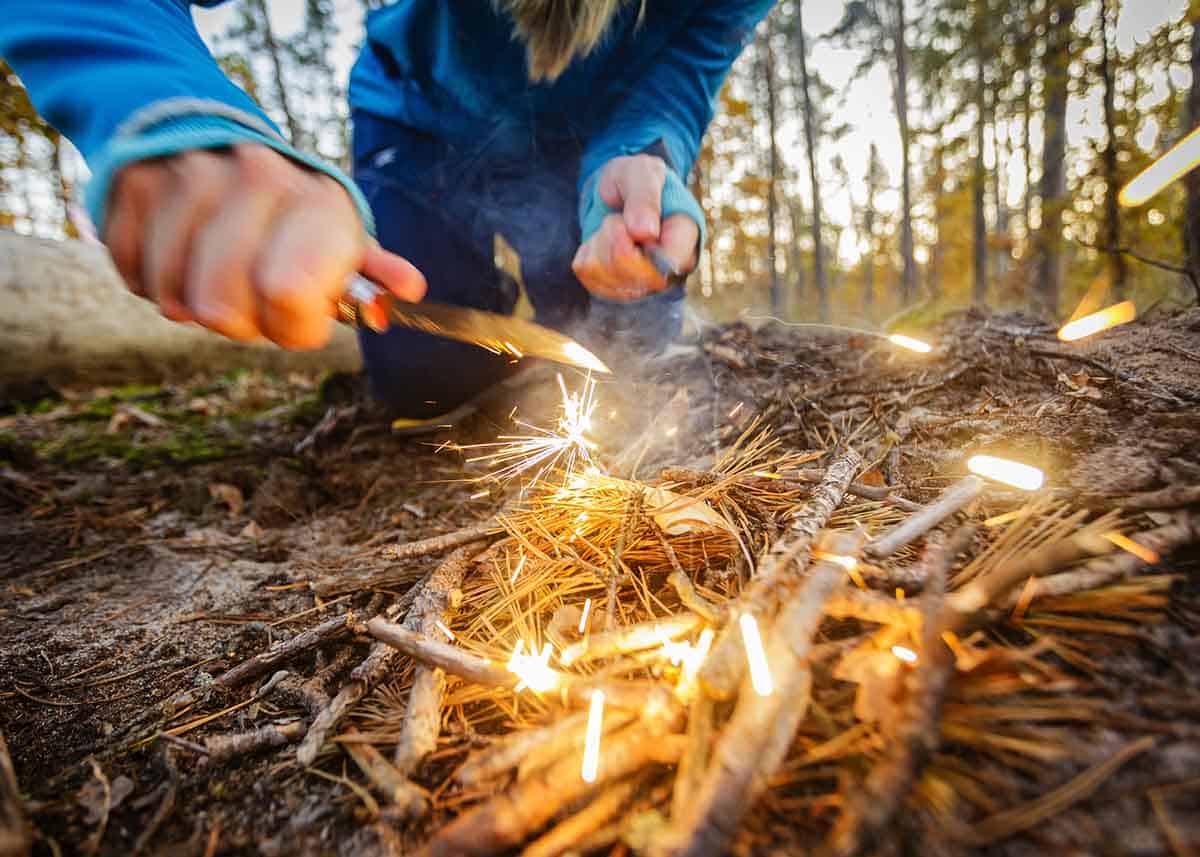
Fire Starting Basics
The best way to start a fire is with a match or lighter. Just strike and light.
If you have no matches, you had better hope you have something else! If you don’t, then let’s get back to the basics.
In the absence of matches or a lighter, you’ll have to use one of these alternative methods to start a fire.
6 Primary Methods to Start a Fire
Here are the primary ways to make a fire, without using a match or lighter. We’ll go into detail on each of these methods.
The first three fire-starting methods (spark, friction, and solar) will be your best option when camping or traveling in the outback.
- Sparks: Cast hot sparks onto a small pile of tinder. This is a fast and easy method.
- Friction: Rub wood together to generate heat and then start a fire.
- Solar Lens: Capture the heat of the sun and concentrate it into a small area to start a fire. A magnifying glass is a great way to start a fire using solar energy.
- Chemicals: Mix specific chemicals that, when mixed, will combust. This is an uncommon method for outdoor adventurers to start a fire.
- Fire Carrying: While not commonly used in North America, bringing hot coal on a trip is a great way to make a fire. There are a number of safe ways to carry fire from one site to the next.
- Find Fire: Depending on where you’re traveling, you might find a source for fire in your environment. Think about lava, a tree that has been struck by lightning, or another campsite with a fire.
Matches and lighters are combinations of these methods.
Matches combine friction (striking the box) and chemicals (on the match head). Lighters combine a spark (flint) and a chemical (lighter fluid).

In this guide, you’ll learn specific methods for each of the six ways above.
For each method, we’ll assume the following: You have fuel – including tinder, kindling, and wood.
1. Start a Fire with Sparks (4 Ways)
A. Flint and Steel
This is a timeless method for fire starting. Strike the steel against a sharp piece of flint.
A spark from flint and steel can generate a spark with a temperature of 2,498 °F (1,370 °C).
Supplies required: Steel and flint.
Flint Technique:
- Place your tinder on the ground.
- Use the sharp edge of the flint to shave against the steel.
- Angle so that the sparks land on the tinder.
Here’s a visual for the striking technique.
B. Firesteel (Ferro Rods)
At first glance, firesteel kind of looks like flint. You strike it and it makes sparks. But it is superior in a number of ways.
Ferrocerium generates temperatures of 6,000 °F (3,315 °C) – more than double that of flint.
Supplies required: Ferro rod and steel
Ferro Rod Technique:
- Place your tinder on the ground.
- Use the metal scraper to scrape against the ferro rod
- Angle so that the sparks land on the tinder.
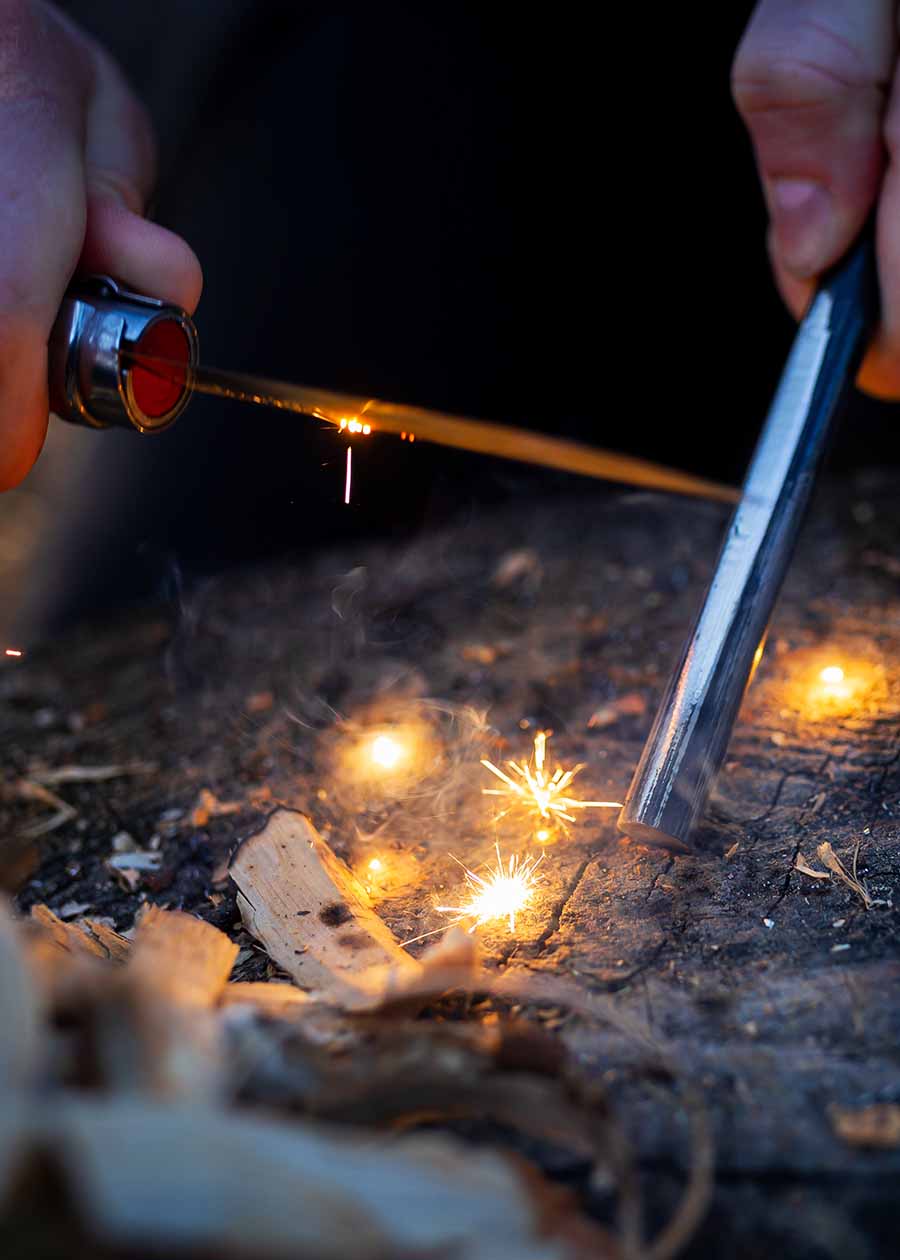
Here’s a visual for the ferro rod technique.
In Europe, ferrocerium is known as Auermetall.
Ferrocerium is composed of an alloy of rare-earth metals called mischmetal, containing iron (20.8%), cerium (41.8%), lanthanum (24.2%), and 4.4% of each praseodymium, neodymium, and magnesium.
C. 9V Battery and Steel Wool
If you don’t have matches, you can start a fire with batteries and some steel wool (you never know what you may have in your car).
Supplies required: 9V battery and steel wool.
Battery and Steel Woold Technique:
- Place your tinder on the ground.
- Add small amount of steel wool to the tinder
- Place your 9V battery against the steel wool. This creates a circuit. Once it begins smoking or ignites, you can remove the battery.
Here’s a visual for the ferro rod technique.
What about AA or AAA batteries? I’ve heard that you can also use AA or AAA batteries. To do this, join them side by side (tape or strap). Then connect the steel wood from the positive end of battery 1 to the negative end of battery two. This will create the same effect as the 9V battery.
If you’ve tried this with AA batteries, I would love to hear how it went for you.
What about dead 9V batteries? I’ve read that you can even use an almost dead 9V battery to start your fire. While it might not have enough juice to run your device, it could still overload the steel wool and cause a fire.
D. Flashlight Battery and Gum Wrapper
This one might seem surprising at first. But the science is the same as with steel wool. You’re basically causing a makeshift cable to overheat and ignite into flames.
Supplies needed: battery and foil gum wrapper
Battery and Gum Wrapper Technique:
- Place your tinder on the ground.
- Cut the gum wrapper to have a narrow bridge, about 3/32″ (2 mm), in the middle. This will cause it to overheat and burst into flames.
- When you connect the two ends, hold the narrow bridge next to your tinder. The wrapper will quickly ignite and quickly burn out.
Here’s a visual for the gum wrapper technique.
Do you know? How Hot is a Campfire?
2. Friction: Lighting a Fire Without Matches (3 Ways)
Fire by friction causes the fuel to heat up to the point of combustion and ignite. This temperature is about 660 °F (350 °C) and so you can imagine it is not easy.
The presence of moisture is going to be the biggest cause of resistance to this method. If it is humid you will find this a lot harder, but if it is dry and you have very dry wood it is possible.
Ideally, you want one piece of wood that is harder than another, and you want wood without too much resin. Resin will cause the wood to polish rather than generate heat from friction.
Any of these methods should be used once you have things ready to go and are in close proximity to the tinder pile so that any early fire is easily transferred.
You will need to choose which option to use, I would recommend one of the following two:
E. Fire Plow (Friction Fire Starter)
You will need a plow board of softer wood that is flat, a couple of inches across and a couple of feet long.
You will also need a plow stick that is harder, thinner, and sharpened at the end.
- Cut or rub a depression about 6-8 inches long in the plow board; the snugger that the plow stick will fit into this the better while still being able to run up and down smoothly.
- Position the board steady either by leaning on it, holding it between or across your legs, and point the plow stick into the board at a 60-degree angle while pushing it forward with downward pressure.
- Once you have reached the end, release the downward pressure and return to the beginning.
- Repeat this movement back and forth quickly, creating wood dust at the end of the trough. Ensure that each stroke ends at the same spot to gather dust there.
Once the wood dust combusts, it can be pushed into the tinder and developed from there.
Here’s a visual guide to starting a first with a fire plow.
F. Hand Drill (Friction Fire Starter)
For this method, you’ll need just two things – a drill stick and a hearth board.
- Choose a straight stalk or stick for a drill, about 18-24 inches in length and ideally as smooth as possible, with no side branches.
- Smooth this drill of all roughness as you will be rubbing between your hands and do not want to damage your palms.
- Next, find a suitable piece of wood to use as a hearth board, this will be a fairly flat piece of wood about an inch thick.
- Cut a small depression in the hearth board within which to place the drill stick. Hold the hearth board firmly in position, with your knee perhaps, and place the drill stick in the depression and twirl to ensure it is the right fit.
- Carve a notch into the center of the depression so that the wood dust can accumulate here.
- Continue to twirl the drill stick between your palms, returning your hands to the top of the drill every time they reach the bottom.
When you see the wood dust start to smoke, transfer it immediately to your kindling.
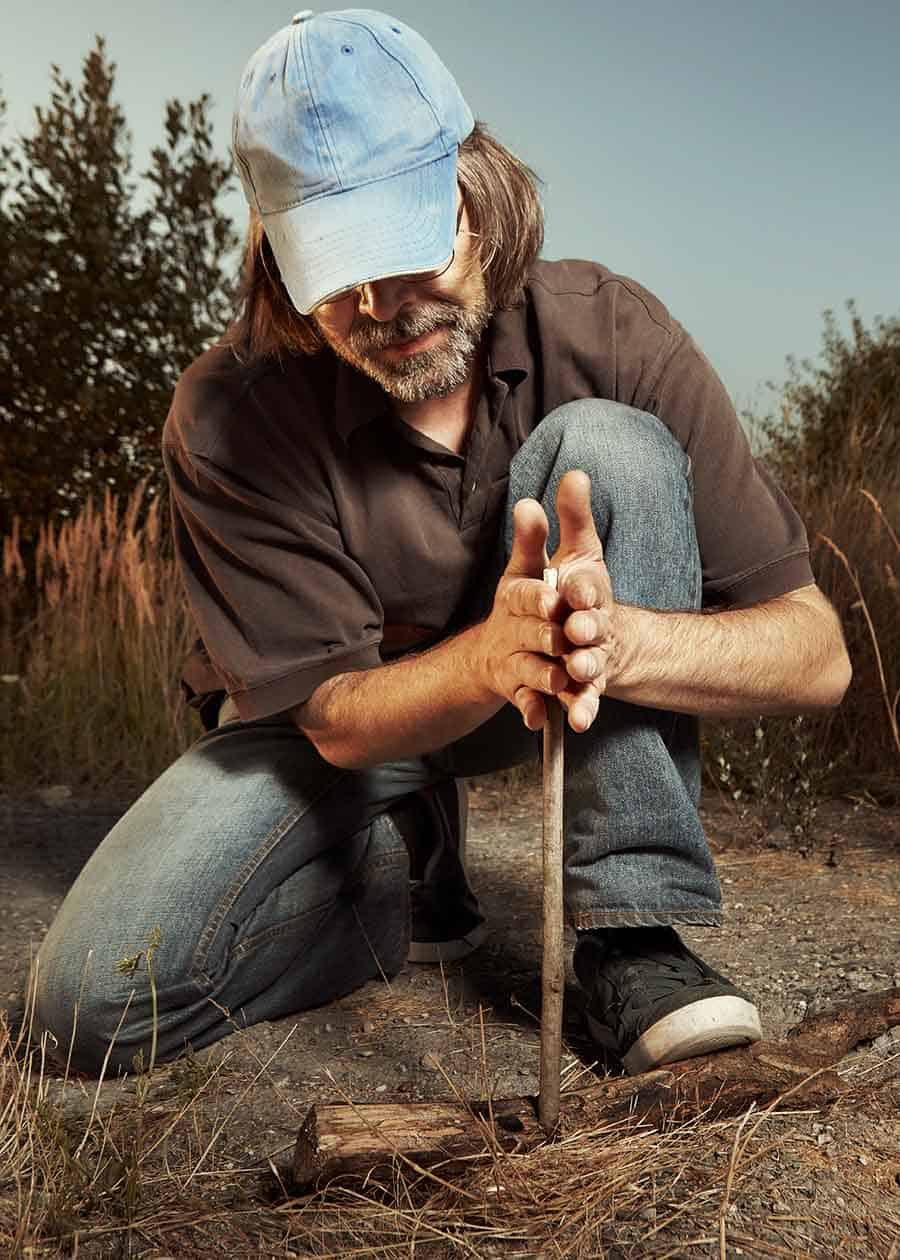
Up your campfire skills with our huge set of campfire guides.
G. Fire Bow Fire Starting Method
This method is very similar to the previous (wood drill) method. The difference is that the spinning action is from the bow instead of your hands.
The fire bow requires a little less physical effort than the hand drill. And it can be done without the need for a lighter-weight drill stick, like in the previous method.
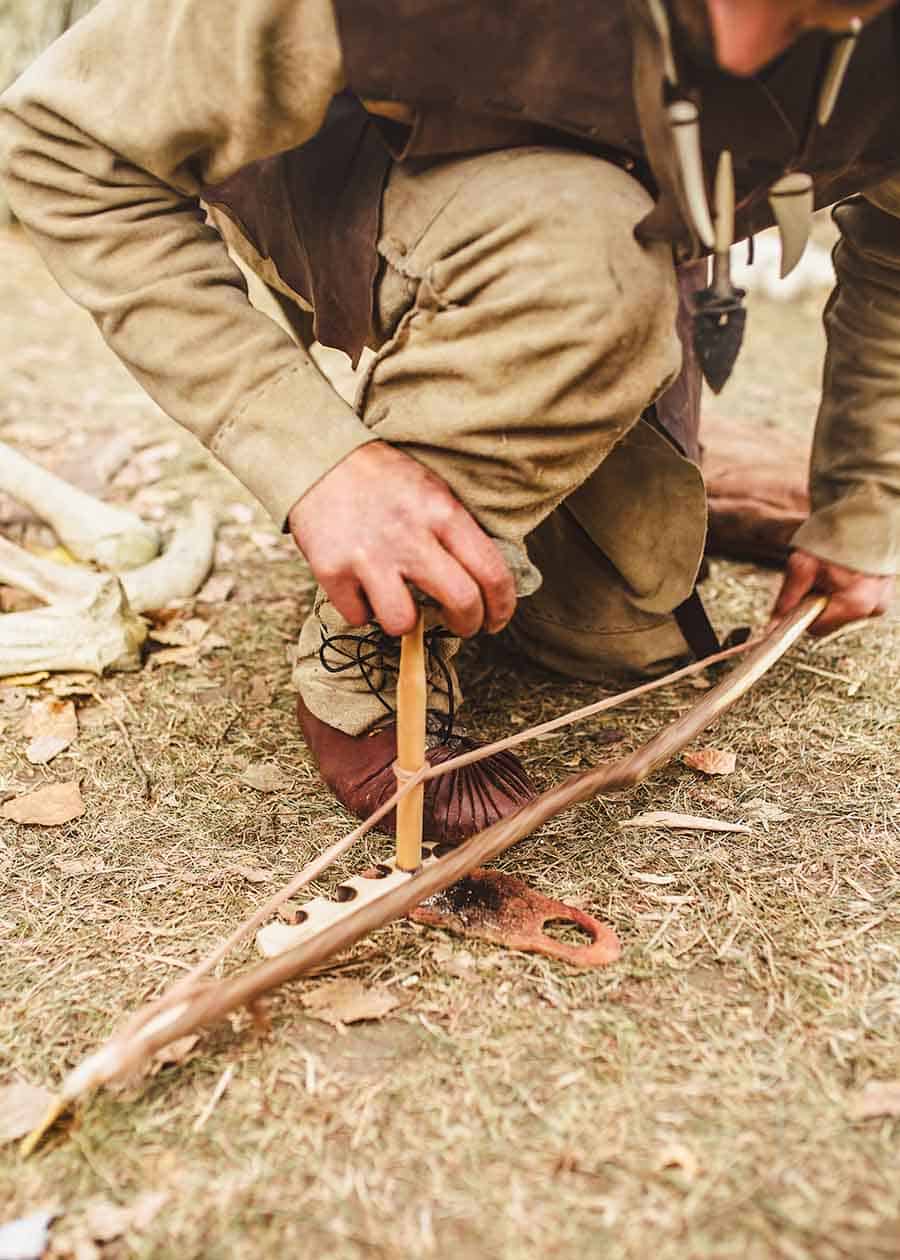
Here’s how to do this method:
3. Solar Lens: Start a Fire With the Sun (5 Ways)
The basic principle of using a solar lens is to concentrate and focus the power of the sun to start a fire.
Each of these methods requires using a common object to focus the sun’s energy on a single point.
H. Water in a Bag
To do this, you’ll need a plastic bag. Almost any bag will do – a Ziploc or snack bag – as long as it’s clear, not opaque. And water. Even urine can do in a pinch.
Snack Bag Fire Starting Technique
- Prepare your tinder and kindling.
- Fill a sandwich bag half full with clear water.
- Twist the bag, forming a sphere.
- Hold the sphere-shaped bag over your prepared kindling, carefully focusing the sunbeam until it begins to smoke.
- Carefully add more tinder, then transfer ember to grass and kindling.
Here’s a great video explaining the method.
I. Soda Can and Toothpaste
This method requires just three things: soda can, polish, and sunlight.
Use toothpaste, chocolate, or fine soil to polish the matte finish off of the bottom of a soda can. This will increase its reflectiveness and allow you to create a single focal point.
Once polished, make sure to clean all the material off the bottom of the can. You’ll want it as reflective as possible.
The bottom of the can functions similar to a glass magnifying glass. Because of its concave shape, it intensifies the sunlight, creating an intense ray of light.
Hold the can bottom close to your tinder. On a sunny day, it can start a fire in just seconds.
You never know what garbage might be laying around the woods. This method can work in a pinch.
J. Glass Lens
This is probably the most common way to start a fire with solar energy.
You can use a magnifying glass, binocular lens, or even eyeglasses. The thicker the glass, the better the beam you’ll get.
Hold it in open sunlight, just above your tinder. Adjust the beam by moving it closer or farther from your tinder pile.
Putting water on top of your lens can increase the intensity of the beam,

K. Ice Lens
This method is similar to the glass lens. Using a well-shaped piece of ice, you really can make fire from ice.
To start a fire from ice, you’ll want to find a piece of ice that is clear – without visible sediment or dirt. Depending on the piece of ice, you might need to shape it with a knife.
You’ll want to choose or make a piece of ice that is thicker in the middle and thins to the edges. This will allow it to focus the sunlight and create a defined beam of light.
Once you have your piece of ice shaped, you’ll want to polish it. Smooth and shiny is the goal. You might be able to melt the surface with your hands. Or maybe immerse it in water to remove any matte surface.
Similar to other solar lenses, you’ll need to find the sweet spot where the beam is most intense.
L. Bottle of Water or Ballon Filled With Water
A final method for catching solar power to start a fire includes basic stuff that might be in your pack.
You can use any material that is clear and can be shaped to intensify sunlight.
You can use a bottle of water, a balloon, or any clear plastic or latex material that can hold water.
To get the best beam, you’ll want to shape the balloon into a sphere. This will focus as much light into a single point as possible.
4. Chemicals
These methods require a little more planning and are more dangerous that the above methods. You’ll need to source and purchase these chemicals.
Warning: These are dangerous and should not be used indoors.
M. Potassium Permanganate and Sugar (or Glycerin)
Potassium Permanganate reacts with combustible materials. It isn’t combustible on its own but it increases the combustibility of other substances.
The exothermic reaction quickly ignites. The outside temperature affects ignition time – the colder the weather, the longer the reaction will take.
When mixed with sugar, you’ll get a yellow-blue flame. When mixed with glycerin, you’ll see a purple flame.
Warning: Potassium Permanganate is a dangerous chemical and can burn your skin and harm your lungs if inhaled.
N. Ammonium Nitrate
Similar to Potassium Permanganate, Ammonium Nitrate is also an oxidizer that accelerates fires. Ammonium Nitrate is used as a fertilizer and has also been banned in some countries.
To make a fire with Ammonium Nitrate, you will add salt and zinc powder.
5. Fire Carrying
While not commonly used in North America, bringing hot coal on a trip is a great way to make a fire. There are a number of safe ways to carry fire from one site to the next.
6. Find Fire
Depending on where you’re traveling, you might find a source of fire in your environment.
Think about lava, a tree that has been struck by lightning, or another campsite with a fire.
While not a primary method of starting a fire, it’s good to think out of the box. If you don’t have the supplies needed to start a fire without a match, can you locate a source of fire nearby?
7. Fresnel Lens (Just for Fun)
Fresnel lens is a solar lens, bending light to focus on the center of the lens. A common source of fresnel lenses is in those old projection televisions.
Not really a great option for hiking, but might be fun for starting a fire in the backyard.
It can generate temperatures of 2000 °F in just a few seconds. This can be a fun project but can generate dangerous levels of heat. Caution is needed when working with a fresnel lens.
And there you have it. That’s how to start a fire without matches or a lighter.
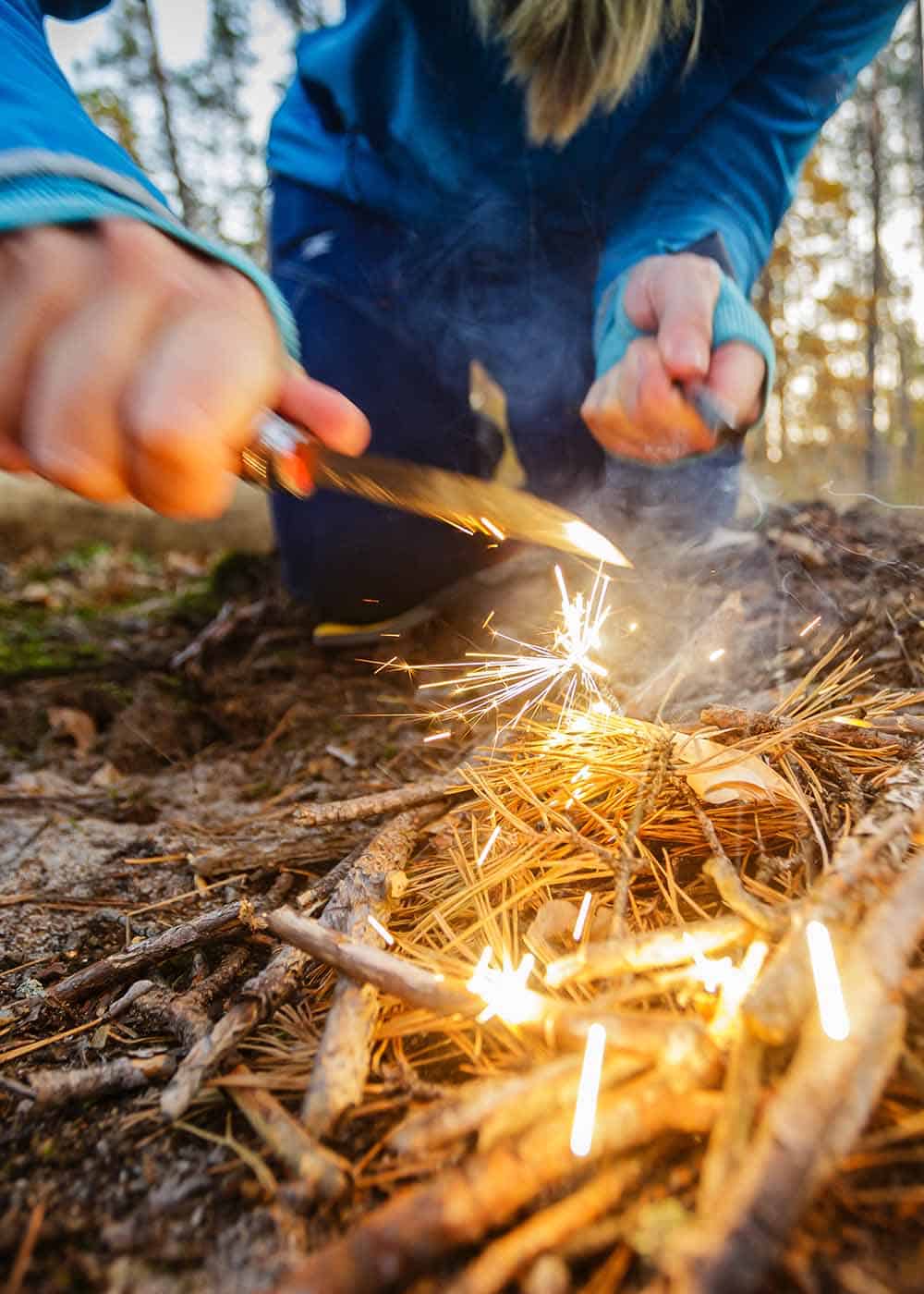
Next up: Here’s how to build the perfect campfire.
Your Turn
How did it go for you? What method did you use to start a fire? Did I miss one? Please share other methods below!

